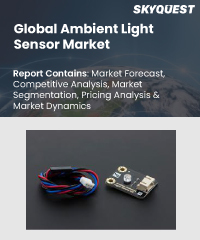
Product ID: SQMIG45J2201

Report ID:
SQMIG45J2201 |
Region:
Global |
Published Date: February, 2024
Pages:
197
|
Tables:
64 |
Figures:
74
Global Ambient Light Sensor Market size was valued at USD 692.03 million in 2021 and is poised to grow from USD 764 million in 2022 to USD 1685.96 million by 2030, growing at a CAGR of 10.4% in the forecast period (2023-2030).
The global ambient light sensor market has been experiencing vast increase, driven with the aid of the increasing call for smart gadgets and the developing emphasis on electricity performance in numerous industries. Ambient light sensors play a crucial function in adjusting the brightness of presentations in smartphones, drugs, and different electronic devices, providing customers with most advantageous viewing studies at the same time as keeping strength.
The number one cause of this marketplace is to cater to the escalating want for adaptive brightness control in digital gadgets, making sure an unbroken and power-green person enjoys.
One of the predominant driving factors behind the enlargement of the ambient mild sensor market is the considerable adoption of clever technologies across industries. As the Internet of Things (IoT) continues to proliferate, the integration of ambient mild sensors in clever homes, automotive programs, and business settings will become an increasing number of crucial.
These sensors make a contribution to enhancing user consolation and standard strength performance via automatically adjusting lighting fixtures conditions based on the encompassing environment.
However, the market isn't always without its challenges and restraining elements. The complexity of integrating ambient mild sensors into various gadgets poses a project for producers, as standardization becomes important to ensure seamless interoperability.
Additionally, worries related to privacy and facts protection may also restrict the market's increase, as ambient mild sensors collect records about the consumer's environment.
Despite these challenges, the ambient light sensor market presents lucrative opportunities for innovation and growth. Advances in sensor technology, and ongoing R&D efforts can meet current challenges and develop sophisticated and reliable environmental light sensors
Furthermore, for energy conservation and sustainability, increased awareness offers market players the opportunity to develop solutions that align with these global priorities. In conclusion, the global ambient light sensor market is driven by the demand for intelligent and energy efficient technologies.
While there are challenges such as standards issues and privacy concerns, the market outlook is promising, with opportunities for innovation and growth in sensor technology as businesses drive sustainability previously, the ambient light sensor market was poised for further expansion and consolidation across industries.
Our industry expert will work with you to provide you with customized data in a short amount of time.
REQUEST FREE CUSTOMIZATIONWant to customize this report? This report can be personalized according to your needs. Our analysts and industry experts will work directly with you to understand your requirements and provide you with customized data in a short amount of time. We offer $1000 worth of FREE customization at the time of purchase.

Product ID: SQMIG45J2201